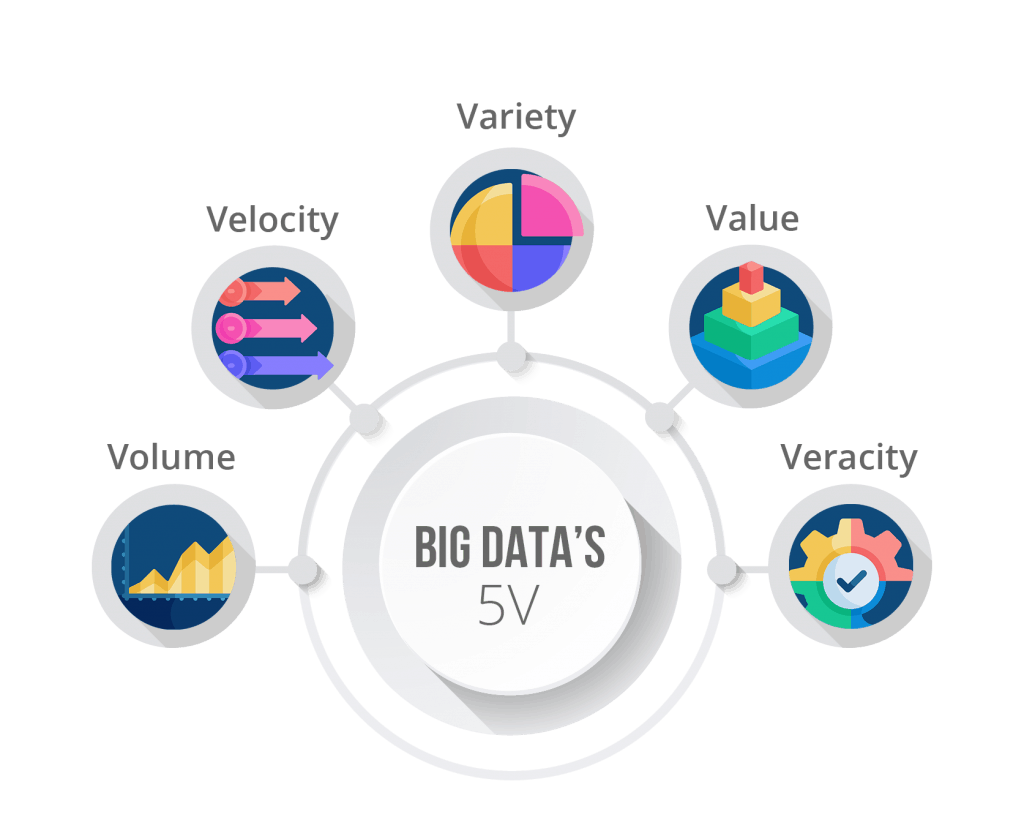5V’s of Big Data: Big Data refers back to a big quantity of facts an business enterprise holds, gathered via various assets, that is exponentially growing. These assets can variety from e-commerce, social media, seek history, transactions, and all different virtual sports accessed via virtual devices. Big Data is a set of dependent and unstructured facts, that is too complicated to use, however, the expansive area is likewise well-prepared to deal with it. The vast area extends non-conventional approaches to investigate big volumes of facts and extract a price from its raw shape to achieve treasured insights for groups and organizations(5V’s of Big Data).
Data collection is simplest treasured so long as groups recognize a way to extract a value from them. Today, retrieving purchaser information is only a survey shape away, however, what approximately is the usage of it to enhance inadequate resources? Raw information will become vain withinside the absence of insights generated from them, and huge information increase diverse offerings to deliver out pertinent information, beneficial in enhancing missing processes. The growth of virtual accessibility has made it simpler for corporations to goal their clients online with personalized tokens and gives explicitly curated for them via AI, social media, or different net applications. However, an excessive amount of information can bring about zero results if the application is inaccurate.
Characteristics of Big Data
To better understand big data and its have an effect on diverse enterprise endeavors, the characteristics of big data are divided into 5 categories, additionally called the 5V’s of Big Data. Let’s study greater approximately those 5 V’s to understand their effect!
Volume
The volume of big data directly refers to its size, composed of big quantities of facts compiled via numerous assets. These sources can also add vary from social media, e-trade, sensors, economic transactions, and plenty more. The extent of facts is essential in figuring out if it comes under the class of massive facts. For example, facts retrieved through hits on a local internet site are relatively lesser than what an e-trade internet site compiles in a day – each is large for producing insights, however, the length of facts is extra on e-trade systems than on a local website.
Velocity
The rate of data flow at which data is generated is one key issue of big data. The continuous flow of data determines how fast and extensive data is being processed and meeting customers’ needs. The velocity of data successfully governs the continuity in the data flow to understand its amount. If the statistics aren’t always non-stop, it isn’t always large sufficient to be taken into consideration under big data. The maximum outstanding sources of data are social media sites, sensor machines, and networks. Velocity is more than extent as high-speed statistics float is usually desired over masses of statistics at slow speed.
Variety
The third V of big data refers to the variety, which regulates the style of information being received. Before fast digitization, information forms has been limited, starting from documents, pdf, etc., however, now information forms are greater diverse. Images, videos, and GIFS are some regularly used information factors shared via way of means of millions of people. The data range is likewise divided into 3 categories: structured, semi-structured, and unstructured information. The significance of range is applicable to its serving organization. For instance, the customer support branch should harness and examine customer information and now no longer sales data.
Veracity
This class refers back to the nice of facts acquired. Veracity refers back to the uncertainties and inconsistencies of accumulated data which often gets messy with the big quantity and numerous sources. It is vital to have it filtered and structured according to the applicable area to make the maximum out of a given dataset.
Value
Relevant data is vital for extracting significant insights. Analysts say negative information best can do more harm than good, which is why collected information is processed through numerous parameters to extract valuable information. Data scientists and analysts examine raw information, that’s prepared and cleaned to retrieve the maximum useful information. This information is similarly analyzed and processed with sample identity to determine if it’s miles precious or not.
